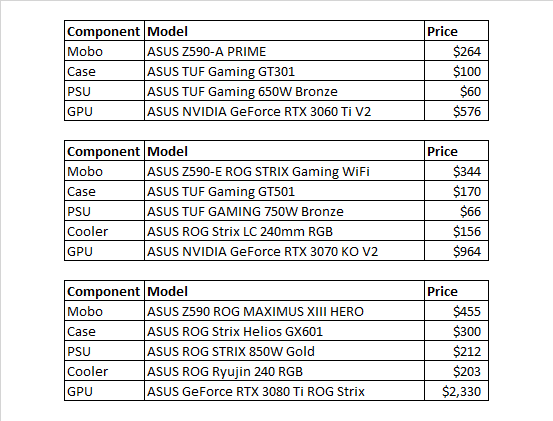Asus and Micro Center Partner to Offer Build-Your-Own PC Kits
New web tool helps you build Asus desktops.
Micro Center has partnered up with Asus to provide a new PC Builder Tool that gives novice PC builders an easy way to assemble the parts for a new gaming PC by doing most of the part selection for you. More importantly, it's a way to guarantee getting an RTX 30-series graphics card, one of the best graphics cards, though at a rather high price. Think of it as another form of bundling, similar to the Newegg Shuffle, but without the lottery aspect.
You have the option of choosing one of three tiers: Value, Performance, and Ultimate. There are options for either Intel or AMD platforms on each tier. However, each system comes configured as a barebones system, meaning it's missing the CPU, Storage, RAM, and even the OS. You will have to add those system components separately, which quickly bumps up the price. You can also have Micro Center build the system out for you for $200, if you select all the extra components and OS, or you can do it yourself.
Effectively, what Asus and Micro Center are shipping to you is a DIY barebones kit, or potentially a complete system. What's interesting about this idea is that you can choose the major system components yourself, from a limited selection. The included parts naturally all come from Asus, but you can pick the CPU, RAM, and storage. But on the downside, these options aren't selected for you by default, and you have to pay full price for the OS. That's something the best prebuild desktops and DIY kits like NZXT's BLD kits already do.
It'll be interesting to see how this strategy plays out. Micro Center does have a different build tool that allows a far greater selection of components, but that may not guarantee you a graphics card. We suspect this is a way to get new GPUs into the hands of DIY PC gamers who are trying to put together a new system. But that could mean fewer standalone GPUs for sale, which could make it even harder to grab a GPU on its own from Micro Center if some of the company's graphics card allocation gets prioritized toward Asus' barebones systems — or at least, most of the Asus graphics card allocation.
Graphics Card Pricing Strategy
With how serious the graphics shortage has become, and the rather horrible GPU prices for cards being sold online, we priced out each build to see if Micro Center is giving you a price that's close to MSRP on the graphics card. Spoiler alert: It's absolutely not.
The barebones systems are by no means cheap and start at $979 for the AMD Value kit, and $999 for the Intel version. Each build comes with Asus-themed components, so the Value build for example includes an Asus Nvidia GeForce RTX 3060 Ti Dual V2 graphics card, TUF Gaming 650W Bronze PSU, and an Asus TUF GT301 tempered glass ATX chassis. You also get either a Z590-A Prime motherboard for Intel builds (starting at $1,000) or a B550-F ROG Strix Gaming motherboard for AMD (starting at $980).
Pricing things out, we found that Micro Center is charging around $575-$600 for the RTX 3060 Ti graphics card. That's $200-ish over Nvidia's base MSRP, though Asus cards often get sold at a premium, though the company's "Dual" line of graphics cards is about as barebones as you can get. There's no RGB and very little in the way of other extras. If we weren't in a severe GPU shortage, these would likely be sold at Nvidia's base MSRP.
The performance PC steps things up a bit by going with a GeForce RTX 3070 KO V2 graphics card, Asus ROG Strix 240mm RGB liquid cooler, Asus TUF Gaming GT 501 RGB case, and a 750W TUF Gaming Bronze PSU. The Intel option includes a Z590-E ROG Strix motherboard and starts at $1,700, while the AMD build includes an Asus B550-F ROG Strix motherboard and starts at a far less painful $1,500.
Unfortunately, graphics card pricing with the Performance setup is pretty rough. Based on our estimates looking at the other components, Micro Center charges a whopping $950–$975 for the Asus RTX 3070 KO. The KO line at least isn't quite as far down the pecking order, as it does include some RGB lighting and a modest overclock, but that's still basically double the theoretical Nvidia RTX 3070 MSRP.
The Ultimate trim level is Micro Center's highest offering in the lineup, giving you a Z590 ROG Maximus XIII Hero for the Intel version, an Asus ROG Ryujin 240 RGB AIO liquid cooler, a tempered glass RGB GX601 ROG Strix gaming case, and an ROG Strix 850W Gold power supply. For the graphics card, you get one of the fastest GPUs around, the ROG Strix RTX 3080 Ti — the triple fan variant, not the RTX 3080 Ti ROG Strix LC that we recently reviewed.
The total price for the barebones kit comes to an eye watering $3,499.99. For the AMD platform, the Z590 board gets swapped out for an Asus X570-E ROG Strix gaming motherboard — no Crosshair X570 Hero, unfortunately. That system starts at $3,299.
Stay On the Cutting Edge: Get the Tom's Hardware Newsletter
Get Tom's Hardware's best news and in-depth reviews, straight to your inbox.
Based on those components, we can get a good estimate of the graphics card price, and it's a doozy. According to our calculations, Micro Center is charging users a whopping $2,330 for the Nvidia RTX 3080 Ti ROG Strix found inside this model. Granted, it can be a bit difficult to find those cards in stock, but Newegg currently has it listed for $2,178.88. And you don't even need to buy other parts alongside it.

Here's our price estimates for the various kits, based on the cost of the other components when purchased online (not necessarily from MicroCenter), with the GPU covering whatever's left. In short, despite guaranteeing customers that each Asus barebones kit will come with an Asus RTX graphics card, the prices are borderline outrageous for the mid-tier Performance and top-tier Ultimate builds. You might even be better off buying an RTX 3080 Ti or RTX 3070 from a scalper on eBay for a lower price (maybe).
The Value kit is more reasonable with a cost of "just" $100-$200 over MSRP. However, you are still getting one of Asus' lowest-end RTX 3060 Ti models, making this offer quite distasteful. And don't forget that these are barebones kits, meaning you need to pour an additional $400-$800 to make the systems usable with a good CPU, memory, storage, and operating system.
It reeks of greed, in other words. Newegg's Shuffle already left a sour taste in many potential shoppers' mouths, and MicroCenter's Asus Build options are effectively just as bad, if not worse. You also have to pick up the PC at the store, which means it's still limited to people who live near a MicroCenter.
But don't worry: You can only order one system from MicroCenter (per month), to ensure everyone can get a chance at a graphics card. That's the same deal as purchasing a GPU on its own, likely at a better price, provided any are in stock. And that's what we would recommend you do, assuming you can find a card that's in your budget.

Aaron Klotz is a contributing writer for Tom’s Hardware, covering news related to computer hardware such as CPUs, and graphics cards.
-
JWNoctis As far as silly greedy business ideas went, how about this: Asian-style lottery boxes that contained PC parts , each guaranteed to contain some new graphic card from the last 5 years guaranteed to at least match the minimum requirement of some hot game, and the rest of the components from similar vintage that are at least guaranteed to fit and work together that sells for, say $500, $1,000, or $2,000 each, only differing by chance of getting more recent and higher-end parts. No need to even pick your own.Reply
Bonus points for putting them inside a vending machine. Or even a claw machine that charges $100 per go and adjusted for profitability.